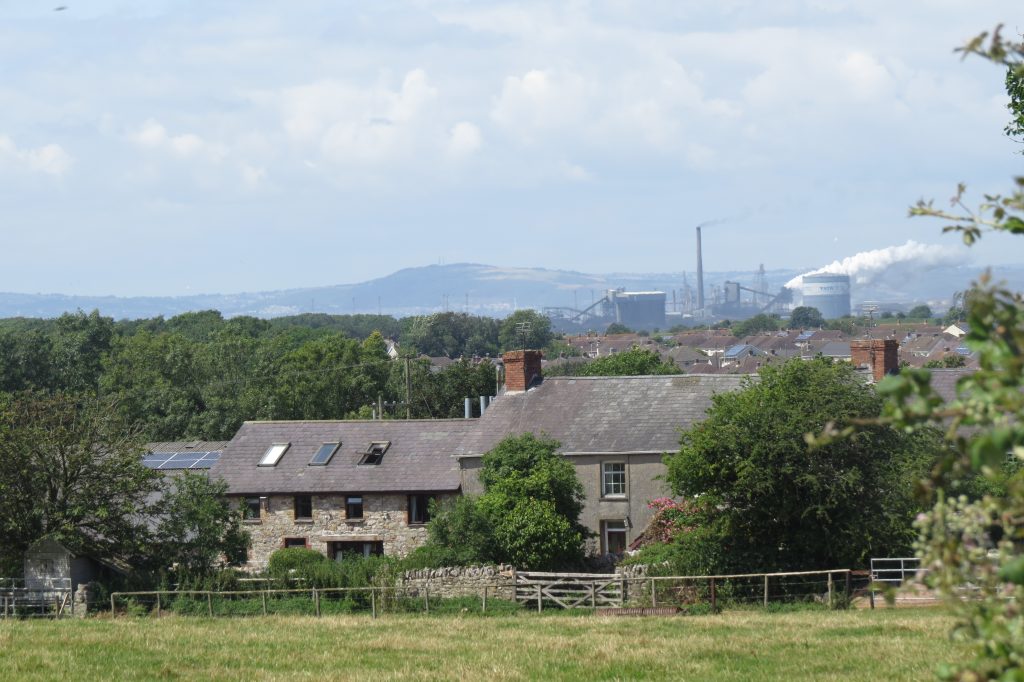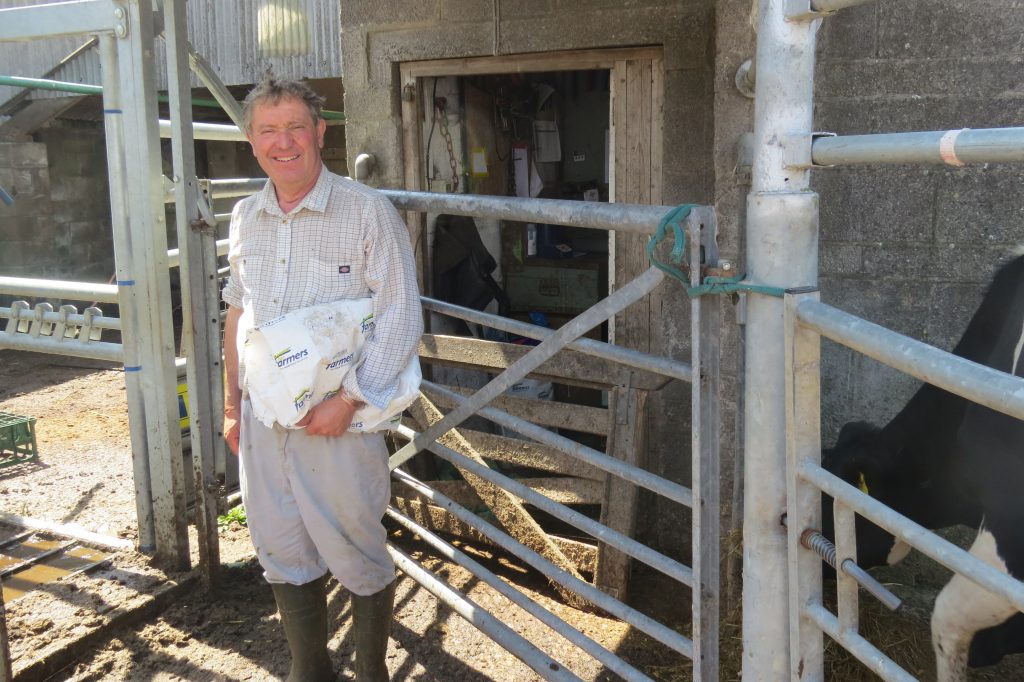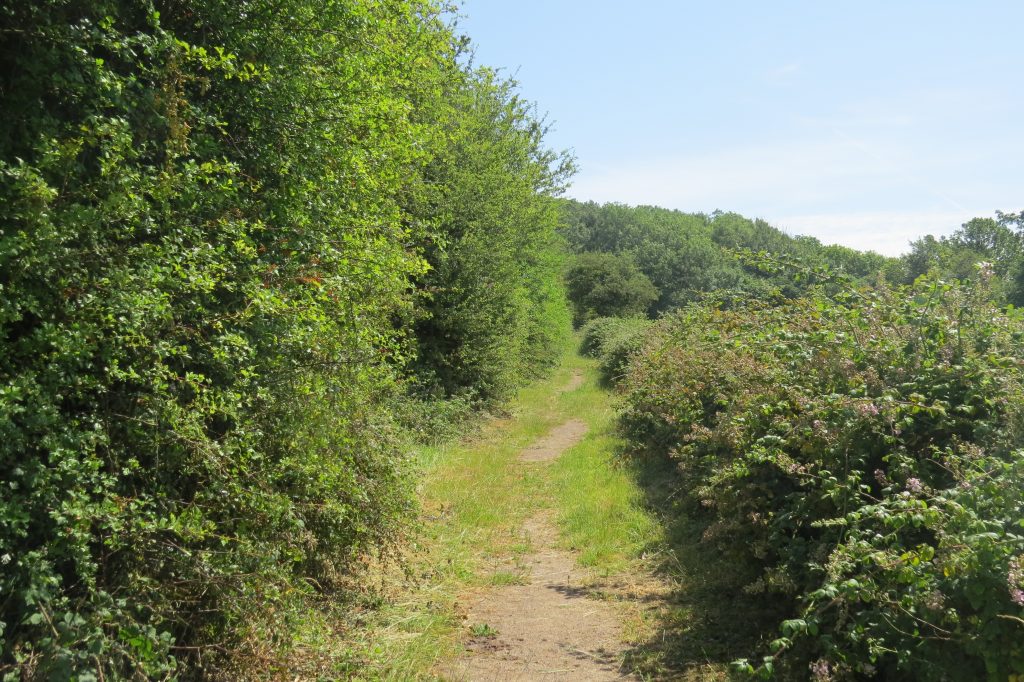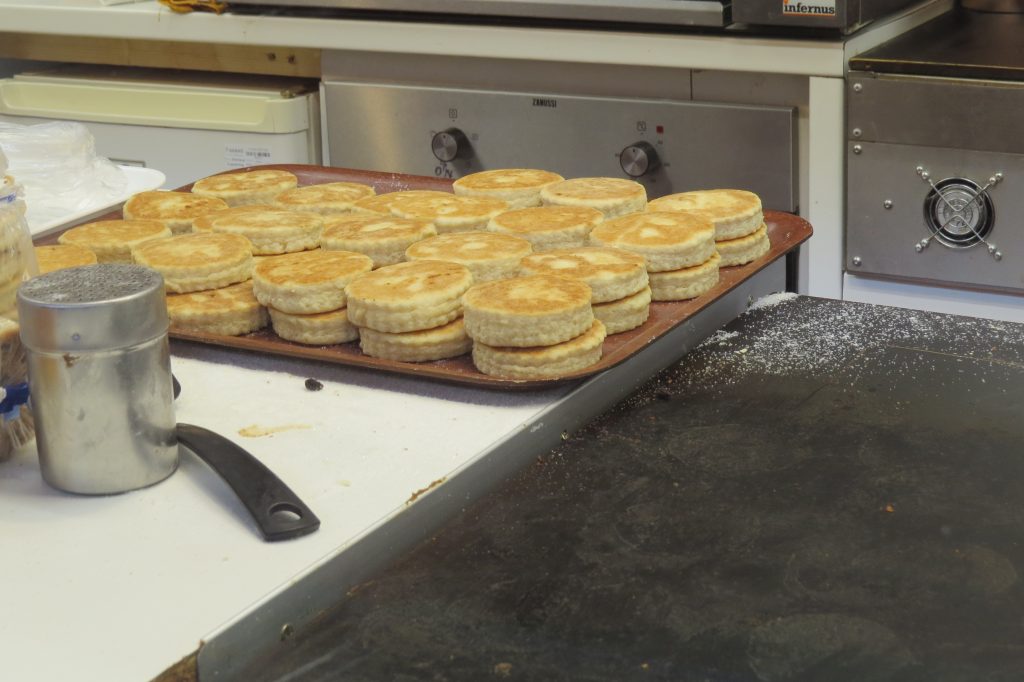[Pwt bach o’r bennod ar fenyn o’r llyfr ‘Welsh Food Stories‘ (sy’n barod i’w gyhoeddi ond yn aros i’r storm economaidd ildio digon i gyhoeddwr benderfynu ei argraffu). Mae’n goleuo sawl ambell agwedd o’r gyfres bresennol. Parhawn a honno wythnos nesa…]
Another extract from ‘Welsh food stories’:
…Salty butter, in particular, spread generously on a chunk of fresh, crusty bread, is the taste of home. With abundant rainfall and a mild climate all year round away from the mountainous interior, much of Wales is good butter country and has long been recognised as such. As John Evans, a travel writer visiting Wales in 1804 wrote:
‘The excellency of Glamorgan butter is too well known to need any eulogy…. Great quantities are annually salted and exported to Bristol and other places. This article of luxury seems to have been invented by the natives.’
Butter is of course the product of churning cream, and was traditionally made on most farms or smallholdings in the country. A product valued wherever it was made for its flavour, keeping properties and high fat content, butter seems to have been held in high regard in the Celtic countries. In Ireland, butter was used as a form of currency, and for many poorer people would have been one of the main sources of income and dietary fat. William Camden’s description of Britain, Britannia, published in 1586, makes a point of describing the diet of the population of mountainous north-west Wales, so different in language and culture to his native London; ‘the inhabitants, ….for most part wholy betake themselves to breeding and seeding of cattail, and live upon white meates, as butter, cheese &c’. This upland, pastoral economy, far from meaning that the population lived in poverty, formed the basis for not insubstantial wealth. One of the greatest concentrations of medieval and sub-medieval farmhouses in Wales lies in Snowdonia, with houses like Gwastadannas, Nantgwynant or Egryn, Llanaber visible manifestations of prosperity.[1]

Early visitors to Wales remarked on the plentiful butter they found there. John Taylor, who visited Carmarthen in 1652, described it as ‘one of the plentifullest townes that I ever set my foot in, for very fair egs are cheaper than small pears’. He goes on to list the prices he found for various foodstuffs at the market there, including, ‘Butter as good as the world affords, two pence halfepenney, for three pence the pound.’ Similarly, Nathaniel Crouch says of the food of Flintshire in the north-east in 1695, ‘fruits are not very common; but of milk, butter, cheese and honey there is plenty’. Along with other dairy products, butter seems to have been ubiquitous in past Welsh diets.
One of the distinctive features of the tradition of butter making is of course its saltiness. Salt was added to butter from prehistoric times as a preservative. The salt content in butter varied traditionally across Europe; in Normandy, the local Isigny butter traditionally has a salt content of 2%, whilst in most parts of Germany most butter has been unsalted since the Middle Ages, as a result of salt taxes. In Wales, surrounded by sea on three sides, people were able to keep their predilection for salty butter; a common benchmark today is 3.5%.
Another notable feature of Wales’ butter making culture is the old, now mostly forgotten tradition of butter presses, or moulds. Each farm or dairy had its own wooden press, used to stamp the name or mark of the farm onto a slab of butter – effectively fulfilling the same function as a label or logo today. These presses are objects of beauty, often inscribed with the pattern of a thistle, a leaf, or other natural objects. Hundreds remain on farmhouse mantelpieces and in museums the length and breadth of the country. They testify to a culture in which people cared about the quality of the butter they bought, and where buttermakers took pride in marketing their ware as theirs.
Through the twentieth century there was a marked decline in the number of local dairies in Wales. Refrigeration combined with low transportation costs combined to to give a significant advantage to companies that could operate at economies of scale. As was widely the case across northern Europe, milk rounds went from being the normal way of having French milk, to being one option among many, to being a comparative rarity.

One of the few family farms that still makes its own butter in its own dairy today is Tŷ Tanglwyst, near Porthcawl on the Glamorgan coast. As Rhys Lougher, the latest in a long line of Glamorgan famers, explains, ‘when we were starting out, there were many more farm dairies like this all over Wales. Many of those have closed in the last ten years or so. What’s against us is the economics’.
Four generations of Loughers live on the farm, with its sprawling sub-medieval farmhouse crouching at the centre. Standing in the old orchard behind the house, Rhys’ father John points out his grandfather’s original dairy at its western end. “They made butter for themselves, of course – like they had the apples and the pears and the raspberries and all too – but like eight or nine other farms round here, they were getting their money from supplying the town of Porthcawl with its milk. There were no fridges, see, so twice a day they’d go in with milk, morning and evening.” He stops and reflects a moment, as we stand there in the warm mid-summer sun, before going on. “He had a herd of shorthorns, my granddad did – just twelve cows. Nobody would make a living with twelve cows today.”
Over the course of the twentieth century, like most farms in Wales the herd size increased, and economics pushed the farm to further specialize in dairy. By the 1990s, the herd was 60 cows strong and supplying the independent creamery in Bridgend with milk. But then Dairy Farmers of Britain, which had ended up running the dairy, went bust, as John recalls, “15 milkmen came knocking on our doors the very next morning, more or less! Well, we couldn’t take them all on, far from it – but that was the start of it.”
Even before then, economic pressures had pushed them to look into other sources of income. Some of the old, stone farm buildings had been turned into holiday lets. They put some fields down to pick-your-own strawberries; “that worked and we had lovely strawberries. But then over eight years we saw fewer and fewer customers – it was just when the supermarkets started stocking them all year round and it just became unviable”. They looked into cheese too, visited established cheese producers in West Wales and even started tests for producing soft cheese on site – but the storage, the equipment, and creating a market were significant obstacles. As John said, ‘you can make the cheese all right – but then where do you sell it?’ ” Creating a market for your product is long, slow work.
Then when the Bridgend creamery closed, suddenly there was a market for their milk – but it needed to be pasteurised and bottled first. “Yes, we were catapulted into it a little,” says Rhys with a chuckle, “and we applied for a grant, and when we got it we thought it was an enormous sum! But it all went just for the capital investment – all the new equipment and facilities we would need if this was going to happen. I mean, you think it’s just going one step up the supply chain, it’s not going to be so different to what you already know, but in fact it’s an entirely different world.”

Rhys and John are likeable, affable men, who are obviously very happy to welcome visitors onto their farm – and it’s obvious they are also sharp operators who keep their noses to the ground. The business grew, to the point where they now employ 25 people, making them the largest employer in their village. “Yes, we’ve now got delivery milkmen, farm hands, production staff who do the pasteurising, three people on the butter. We deliver our milk, cream and butter to shops, cafés, restaurants, patisseries, ice-cream parlours all within a 25 mile radius, and most a lot more local than that. And our milk is also going into all the schools here. That’s probably what I am most proud of, because we pushed and pushed for that local procurement from the council. And now, we’ve got those relationships and the kids come up on class visits, to meet the actual cows that produce their milk.”
As Rhys says, they have developed a good brand and they have a good story to tell – one they are proud of. But even so, “the economics are against us. People want cheap food – cheap milk particularly. My ten-year old son is into skateboarding in a big way, and he was telling me recently ‘Dad, when I take over the farm, I’m going to turn it into a skateboard park’. And I can’t argue against it – he’ll have a better business plan than dairy farming!”
Rhys obviously cares deeply about food and farming, and wants to play his part in educating people about what good farming looks like – like the kids he mentions who come on school visits and don’t have a clue that milk comes from cows. And it isn’t just the kids whose food education is lacking. He bursts into laughter as he remembers some of the teachers, “I have had more than one teacher ask me with an entirely straight face ‘Do you get more milk from the cows or the bulls?’ You’ve got to laugh or you’d cry!”
The farm’s 120 acres – which makes it a medium-size family farm in today’s Wales – lies on limestone soils some two miles inland from the coast north of Porthcawl. From the path up to Tŷ Tanglwyst woods you can see north towards the normally cloud-topped Blaenau, the coal-country of the Glamorgan uplands. As your gaze sweeps to the west, you pass Margam Abbey, whose monks owned Tŷ Tanglwyst in the middle ages, and who left their mark not least in the vaulted chamber underneath the original farmhouse. Due north there is a clear view of the now-threatened towers of Port Talbot steelworks, which first more or less created and still sustains that coastal town; that town, in turn, created the neighbouring seaside town of Porthcawl as an August resort for the miners. And then, immediately west lies the sea, stretching westwards past the cliffs of the Gower coast until at a certain point it becomes the Atlantic.

This view would have been one of the reasons the Iron Age inhabitants of Wales chose to build a small fort on top of the knoll now covered in ancient oaks, ash and hazel. They would have farmed cattle on the land too of course, with the stealing of cattle one of the primary forms of self-aggrandizement in Celtic society. The Romans left their remains here too, in the form of half a quern, a hand-mill for grain. Of course, the Celts and Romans in question would some of the time have been the same people, even the same individuals.
The cows currently grazing this land are Holsteins, from a long-established herd stewarded and developed for decades by the family. They are a closed herd (bulls are not brought in from outside for breeding), and have won many prizes over the years. And when I ask Rhys about them, he has no hesitation in answering. “I love working with the cows. Seeing them happy, healthy, carrying the tradition on with the hard. I am genuinely proud of what we do here – I think we have the balance right.”
The cows graze outdoors all the way from early April to early November (“though who knows these days, with the weather changing so much”), but as Rhys emphasizes, it’s cow-led and if they want to stay inside because it’s hot or wet, they can do that. When I visit on a warm day in high summer, the cows are lazing about in the shade of a tall ash tree. Milk is a complex liquid, comprised of a variety of minerals, proteins, sugars and fats. But it is universally recognized these days that the highest quality milk comes from animals fed their natural diet – fresh green grass, clover, foliage and herbs. Milk from pasture-fed animals is higher in vitamin E, omega 3 fats and conjugated linoleic acids than milk from animals fed other diets.[2] And for a much longer part of the year than would be possible in most parts of northern Europe, these cattle graze the pastures (and even in the winter, eat much of the fossilized goodness of the summer pastures in the form of hay.)
The farm system, Rhys tells me, is cyclical, and they are working it making it more so with each passing year. “We use the cattle manure itself as fertilizer, and we’re growing more clover. And although I’m not an ecologist, but it does feel to me like we have a healthy ecosystem here. The insects love the dung pats, we’ve got owls and sparrowhawks here. We have wildflower meadows – like right now, there’s one meadow where we have had orchids flowering, so we’ve not mown it yet. We’ll wait till they’ve set seed before we do that.”
“And we’re now making hay again – things have come full circle in a way, back to the way they were in the past. I’m excited this year because we’ve grown peas to mix with barley as an arable silage for the cows for the first time. My grandmother was out yesterday evening picking them as fast as she could – and then there was my grandfather last night shelling some of them for us for supper, for a good hour! Anyway, all of that is reducing our dependence on bought-in cereals for feed, which is also helping to cut our carbon emissions.”
Given all this, I ask Rhys whether the farm has considered becoming organic. He responds with a wry smile. “It annoys me that a lot of people go organic just to charge the premium. We adopt a lot of the organic principles in what we do anyway – but we couldn’t go organic as things are, because there is such a lack of organic grain grown in Wales, and we couldn’t sustain the cows through the winter at the moment without the grain.”
“But am I for cutting emissions, keeping things local, protecting the wildlife? Just look at my farm! Actually, we’ve been restoring some more hedges recently as well, to create more wildlife corridors; one of the reasons we can’t expand is because the M4 cuts through the country right there”, he indicates – two fields down from the farmhouse.
It is perhaps a cliché in a book on food to say that you can taste the quality of the farming, or the artisanship, in the food itself. But the almost-white butter which the Loughers give me to take home, when I taste it, really does have the texture of cream and in its flavour almost a bouquet of vanilla. Although made from pasteurised milk, and made in the sweet-cream tradition of the British Isles, rather than the arguably richer lactic continental tradition, this is a butter that you could eat with a (tea)spoon.
It is churned on the farm, twice a week. “Tuesday and Thursday are our butter days”, Rhys explains, “and yes, the salt content is 3.5%, as it should be for a Welsh butter. It’s been popular ever since we started making it a decade ago. We get shops ringing us up asking to stock it, and we say that they can only stock it if they’ll take our milk too” (which is equally good, but bulkier and more perishable). “We actually won the Golden Fork for it at the Great Taste awards a couple of years ago – which made us one of the 18 winners out of 10,000 products entered.”

Tŷ Tanglwyst’s butter is used by a number of bakeries; unsurprisingly, given how many baked goods depend on a rich butter flavour for their mojo. And butter has been the key ingredient in traditional cakes and treats from all parts of Wales since time immemorial. Both ‘bara brith’ and ‘Welsh cakes’, the two Welsh ‘sweets’ par excellence, depend on good, rich, salty butter for their mouth-filling moreishness….
[1] Suggett, Discovering the historic houses of Snowdonia, 85 and 111
[2] Lamb, River Cottage: Cheese and Dairy, 18
Comments are closed.